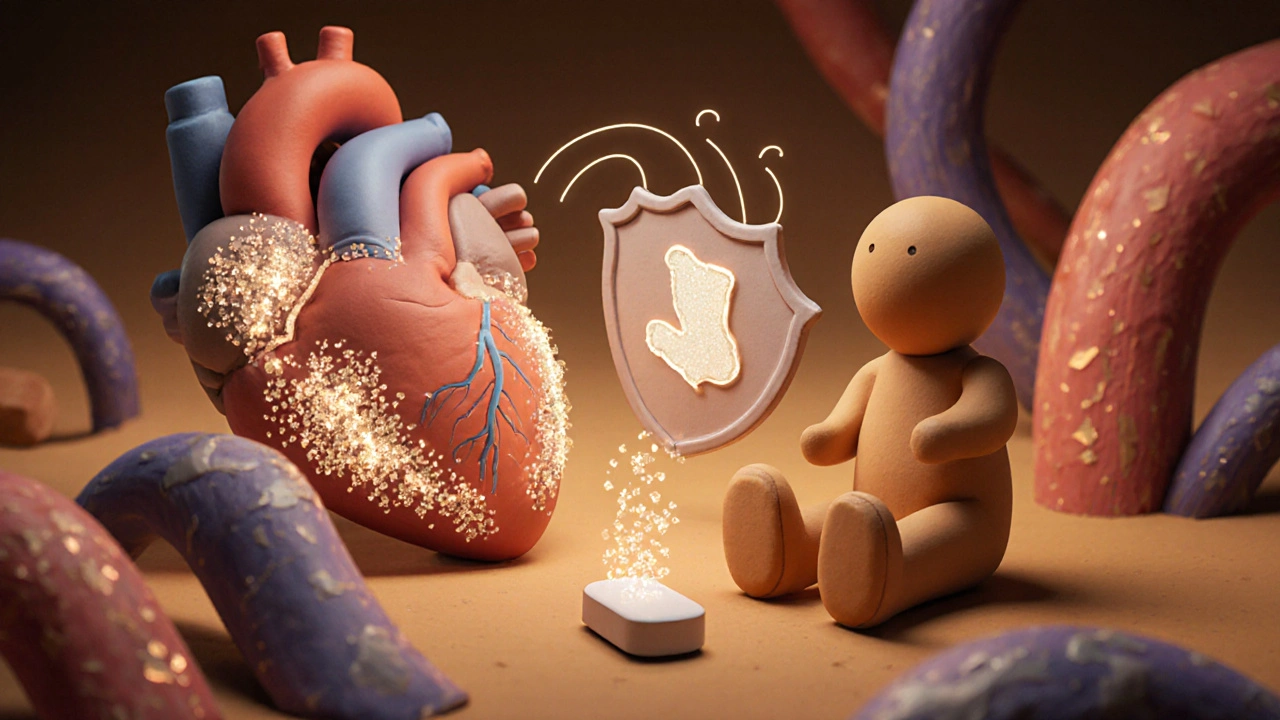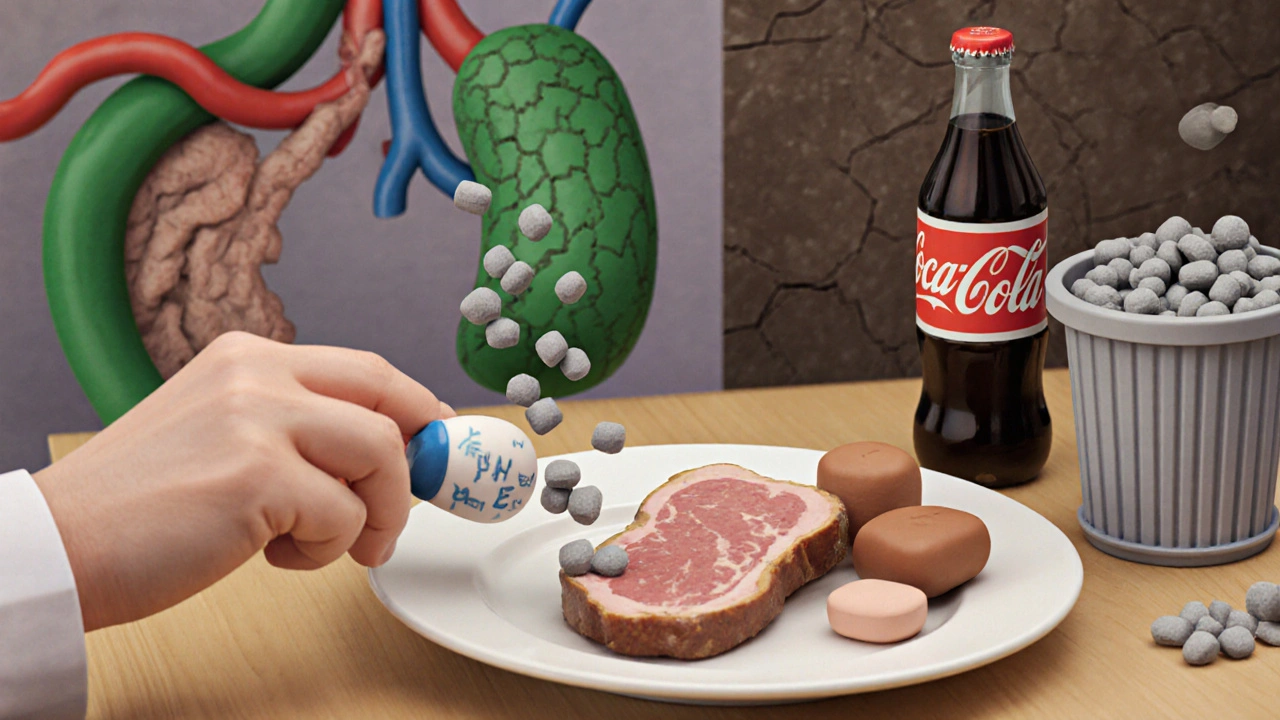How Sevelamer Hydrochloride Reduces Cardiovascular Disease Risk in Kidney Patients

When your kidneys aren't working right, they can't remove excess phosphate from your blood. That buildup-called hyperphosphatemia-isn't just a lab number. It's a silent driver of heart disease. People with advanced kidney disease are up to 20 times more likely to die from heart problems than from kidney failure itself. One of the most effective tools doctors use to break that link is sevelamer hydrochloride.
What sevelamer hydrochloride actually does
Sevelamer hydrochloride isn't a drug that gets absorbed into your bloodstream. It works right in your gut. When you take it with meals, it binds to the phosphate in your food-like a magnet pulling phosphorus out of what you eat. That bound phosphate then leaves your body in your stool instead of entering your blood.
That might sound simple, but the effect is powerful. In clinical studies, patients taking sevelamer hydrochloride saw their serum phosphate levels drop by 20-30% within 8 weeks. That’s not just a minor improvement. It’s the difference between your arteries hardening and staying flexible.
Why phosphate is bad for your heart
High phosphate doesn’t just sit in your blood. It triggers a chain reaction. It makes your blood vessels calcify-like rust forming on pipes, but inside your arteries. Calcium and phosphate crystals build up in the walls of your heart’s blood vessels, making them stiff. Stiff arteries mean your heart has to work harder to pump blood. That raises your blood pressure and increases your risk of heart attack and stroke.
Phosphate also messes with your parathyroid hormone, which controls calcium balance. When phosphate climbs, your parathyroid glands go into overdrive. That leads to even more calcium being pulled from your bones and dumped into your blood-adding to the calcification problem. It’s a vicious cycle, and sevelamer hydrochloride breaks it at the source.
How it compares to other phosphate binders
There are other phosphate binders on the market-calcium-based ones like calcium carbonate or calcium acetate. They work too, but they come with a trade-off: they add more calcium to your body. For someone with kidney disease, that extra calcium can make vascular calcification worse.
Sevelamer hydrochloride doesn’t contain calcium. That’s why guidelines from the National Kidney Foundation and the European Renal Association recommend it as a first-line choice for patients at high risk of cardiovascular disease. It reduces phosphate without increasing calcium load. A 2023 meta-analysis of over 5,000 patients found that those on sevelamer had a 22% lower risk of cardiovascular death compared to those on calcium-based binders.

Who benefits the most
Sevelamer hydrochloride isn’t for everyone. It’s primarily prescribed to adults with chronic kidney disease who are on dialysis. That’s because dialysis patients can’t clear phosphate effectively, even with diet changes. Even then, not all dialysis patients need it. Doctors look at your blood phosphate levels over time. If they’re consistently above 5.5 mg/dL, and you’ve got signs of heart strain-like left ventricular hypertrophy on an echocardiogram-sevelamer becomes a key part of your treatment plan.
It’s also used in some non-dialysis patients with stage 4 or 5 kidney disease who have failed dietary phosphate control. But it’s not a substitute for eating less phosphate-rich food. You still need to avoid processed meats, colas, cheese, and packaged snacks. Sevelamer works best when it’s part of a bigger plan.
What to expect when you start taking it
You’ll take sevelamer hydrochloride three times a day, right before or right after meals. That’s because it only works when food is in your stomach. Missing a dose means you miss binding the phosphate from that meal. Consistency matters more than you might think.
Side effects are mostly digestive. About 1 in 3 people report bloating, nausea, or constipation. These usually settle down after a few weeks. If they don’t, your doctor might switch you to the carbonate form of sevelamer, which is gentler on the stomach. It’s the same drug, just a different salt form.
Don’t take it with other medications unless spaced out by at least 1 hour. Sevelamer can bind to antibiotics, thyroid meds, or immunosuppressants and stop them from working. Always check with your pharmacist before adding any new pills.

The long-term impact
One of the biggest surprises from research is that sevelamer doesn’t just lower phosphate. It also lowers LDL cholesterol-sometimes by as much as 20%. That’s not its main job, but it’s a bonus. Lower cholesterol means less plaque buildup in your arteries. So you’re getting a two-for-one: less calcification and less fatty buildup.
Long-term studies show that patients who stick with sevelamer for more than 2 years have slower progression of heart disease. Their heart muscle doesn’t thicken as much. Their arteries stay more elastic. Their risk of needing a stent or bypass drops.
This isn’t a cure. But for someone with kidney disease, it’s one of the few treatments that directly targets the leading cause of death. It’s not glamorous. You won’t see ads for it. But for thousands of people on dialysis, it’s the quiet guardian of their heart.
What you can do today
If you or someone you care about has kidney disease, ask your doctor for a phosphate level check. If it’s high, ask if sevelamer hydrochloride is right for you. Don’t assume diet alone is enough. Even with strict limits on dairy and soda, phosphate in processed foods is everywhere.
Keep a food diary for a week. Note every meal and snack. Then bring it to your nephrologist. Pair that with a discussion about sevelamer. It’s not just about numbers on a lab report. It’s about how many more years you get to spend with your family, walking the dog, or just sitting in the sun without worrying about your heart.
Can sevelamer hydrochloride cure kidney disease?
No, sevelamer hydrochloride does not cure kidney disease. It only helps manage high phosphate levels in the blood, which is a common complication of advanced kidney disease. It does not repair damaged kidneys or restore kidney function. Its main role is to reduce the risk of heart disease and other complications caused by phosphate buildup.
Is sevelamer hydrochloride safe for long-term use?
Yes, sevelamer hydrochloride is approved for long-term use in patients with chronic kidney disease on dialysis. Clinical trials lasting up to 5 years show it remains effective and generally well-tolerated. The most common side effects-like bloating or constipation-are usually mild and improve over time. Regular monitoring of phosphate, calcium, and vitamin D levels ensures safety over the long term.
Can I take sevelamer hydrochloride without a prescription?
No, sevelamer hydrochloride is a prescription-only medication. It’s not available over the counter because it requires careful monitoring. Taking it without medical supervision could lead to dangerously low phosphate levels or interfere with other medications. Always consult a nephrologist or kidney specialist before starting this drug.
Does sevelamer hydrochloride help with weight loss?
No, sevelamer hydrochloride is not a weight-loss drug. While some people report feeling less bloated after starting it, this is due to reduced gas buildup from phosphate binding, not fat loss. It does not suppress appetite or increase metabolism. Any weight changes while taking it are likely due to dietary adjustments made alongside the medication.
What foods should I avoid while taking sevelamer hydrochloride?
You should limit foods high in phosphate, especially those with added phosphorus additives. These include processed meats (like deli ham or sausages), colas and dark sodas, packaged snacks, cheese, and instant mashed potatoes. Natural sources like dairy, nuts, and beans also contain phosphate, so portion control matters. Your dietitian can help you build a low-phosphate meal plan that works with sevelamer.
How long does it take for sevelamer hydrochloride to lower phosphate levels?
Most patients see a drop in blood phosphate levels within 2 to 4 weeks of starting sevelamer hydrochloride, especially if taken consistently with meals. Full stabilization usually takes 6 to 8 weeks. Blood tests are typically done every 4 weeks at first to adjust the dose. The goal is to keep phosphate between 3.5 and 5.5 mg/dL.
Sevelamer hydrochloride doesn’t make headlines. But for people living with kidney disease, it’s one of the most important tools they have to protect their heart. It’s not magic. It’s science-carefully targeted, consistently used, and life-changing.

William Cuthbertson
October 29, 2025 AT 05:30You know, reading this made me think about how we treat medicine like it's some kind of magic potion-when really, it's just biology doing its slow, stubborn dance. Sevelamer doesn't cure anything, but it buys time. And time? Time is the one thing no one can buy with money. I've watched my uncle go from dialysis three times a week to walking his dog every morning because he stuck with this pill, even when the bloating made him swear at his toaster. It’s not glamorous. No one films commercials with smiling grandmas holding sevelamer bottles. But that’s the quiet heroism of modern medicine: uncelebrated, unsexy, and utterly vital.
It’s like those old stone bridges in the Cotswolds-no one notices them until they’re gone. Then suddenly, you realize how many lives they carried across the chasm. Sevelamer’s that bridge. It doesn’t fix the broken kidney, but it keeps the heart from collapsing under the weight of phosphate rust. And maybe that’s enough. Maybe that’s everything.
I wish more people understood this. We chase the next breakthrough drug like it’s a TikTok trend, but the real heroes are the ones that just… sit there. In a pillbox. With your breakfast. Waiting.
And yeah, it’s a pain to take three times a day. But so is dying at 52 because your arteries turned to concrete. I’d rather be annoyed than dead. That’s the math.
Also, the cholesterol drop? That’s the universe whispering, ‘Hey, I see you trying.’
So thank you for writing this. Not just for the facts-but for reminding us that sometimes, the most powerful thing you can do is just… keep taking the pill.
And if you’re reading this while on dialysis? You’re already braver than most people who think they’re living life. Keep going.
Eben Neppie
October 30, 2025 AT 03:49Sevelamer hydrochloride is not a ‘cardiovascular cure’-it’s a phosphate binder. The claim that it ‘reduces cardiovascular disease risk’ is misleading without context: it reduces mortality by mitigating a *symptom* of uremia, not by treating atherosclerosis directly. The 22% reduction in cardiovascular death cited is from observational data with confounding variables-diet, dialysis adequacy, statin use-all uncontrolled. The 2023 meta-analysis you referenced? It included trials where sevelamer was used alongside more aggressive BP control and vitamin D repletion. That’s not the drug’s effect-that’s the care package.
Also, ‘stiff arteries’? That’s vascular calcification, which is driven by FGF23, Klotho deficiency, and inflammation-not just phosphate. Sevelamer doesn’t touch any of that. It’s a bandage on a hemorrhage.
And the cholesterol-lowering effect? That’s likely due to reduced bile acid reabsorption, not a direct pharmacological benefit. It’s an incidental finding, not a mechanism of action.
Don’t confuse correlation with causation. This drug is useful. But it’s not a miracle. Stop overselling it.
Hudson Owen
October 30, 2025 AT 13:02I appreciate the thorough and compassionate breakdown of sevelamer hydrochloride’s role in managing hyperphosphatemia among patients with chronic kidney disease. The clinical nuances you’ve outlined-particularly the distinction between phosphate binding and systemic cardiovascular protection-are both scientifically accurate and ethically important to communicate.
As a clinician who has managed dialysis patients for over two decades, I can attest that adherence to phosphate binders remains one of the most persistent challenges in nephrology. The gastrointestinal side effects, while often mild, are profoundly disruptive to daily life. The fact that patients persist despite nausea, bloating, and the logistical burden of dosing with every meal speaks volumes about their resilience.
It is also worth noting that the reduction in cardiovascular mortality observed with sevelamer, while statistically significant, must be weighed against the cost and pill burden. In resource-limited settings, calcium-based binders remain necessary, despite their theoretical risks. The guidelines you referenced are appropriate for high-risk populations, but not universally applicable.
Thank you for highlighting the importance of dietary collaboration with dietitians. Too often, we focus on pharmacology and neglect the foundational role of nutrition. This post serves as both a clinical reference and a human reminder: we treat patients, not just lab values.
Milind Caspar
November 1, 2025 AT 07:49Let’s be honest-this is corporate propaganda dressed as medical advice. Sevelamer hydrochloride? A $12,000-a-year drug that Big Pharma pushed because calcium binders were too cheap. The ‘22% lower risk’? That’s from trials funded by Sanofi, the manufacturer. You think they’d spend billions on research if it didn’t protect their bottom line?
And the cholesterol drop? That’s not a bonus-it’s a red flag. Sevelamer binds fat-soluble vitamins too. You’re not ‘protecting your heart’-you’re starving your body of vitamin K2, which is what actually prevents calcification. The real villain isn’t phosphate-it’s vitamin K deficiency. But you won’t hear that from your nephrologist. Why? Because vitamin K2 isn’t patented.
Also, ‘dietary control isn’t enough’? Bullshit. You’re being fed processed food by Medicaid meal programs. That’s where the real phosphate is-in additives like sodium phosphates in frozen chicken nuggets and ‘natural flavorings’ in soda. You don’t need sevelamer. You need to stop eating garbage. But the system wants you dependent. It’s cheaper to give you a pill than fix the food supply.
And don’t get me started on the ‘long-term safety’ claim. Five-year trials? That’s nothing. We’re talking about a drug that binds minerals in the gut. What happens after 15 years? Bone density? Thyroid function? Gut microbiome? No one knows. They just hand you the pill and say ‘take it.’
This isn’t medicine. It’s industrial control.
Rose Macaulay
November 1, 2025 AT 20:44This actually made me cry a little. My mom’s been on dialysis for six years and she takes this stuff like it’s her job. She never complains, but I see her wincing after dinner when she’s got that bloated look. I just wish people understood how much work goes into staying alive with this stuff.
It’s not just the pills. It’s the food logging. The dietitian visits. The ‘no cheese’ rule. The ‘no soda’ rule. The ‘don’t forget to take it before the fries’ rule. It’s exhausting. And no one talks about that part.
Thank you for writing this. I’m going to print it out and leave it on her fridge. Maybe someone else will read it and finally get it.
Ellen Frida
November 3, 2025 AT 07:57so like… sevelamer is kinda like a sponge for phosphorus? but what if your body needs phosphorus? like… isn’t it an essential mineral? i mean, we need it for bones and energy and stuff right? so isn’t this just… robbing peter to pay paul? and also, i read somewhere that phosphate is in everything now-even organic food has it? like, how are we supposed to avoid it if it’s in the air? also, i think the heart thing is just a distraction from the real issue which is that we’re all being poisoned by corporate food and the medical system just wants to keep us on drugs forever… but i still think sevelamer is kinda cool? like, it’s a little pill that goes ‘nope’ to phosphorus? 🤯
Michael Harris
November 4, 2025 AT 04:17Wow. Another feel-good, corporate-approved article that ignores the real problem: this drug is prescribed to people who are too poor, too lazy, or too uninformed to change their diet. You don’t need sevelamer if you stop eating processed junk. Period.
And let’s talk about the ‘bonus’ cholesterol drop. That’s because sevelamer binds bile acids-so your liver has to use up more cholesterol to make new ones. That’s not a benefit. That’s a metabolic hack with long-term consequences we’re still blind to.
And you call it a ‘quiet guardian’? No. It’s a Band-Aid on a gunshot wound. The real guardian is a damn dietitian and a grocery list that doesn’t include ‘phosphate additives.’
Stop glorifying pharmaceutical crutches. People with kidney disease aren’t victims of biology-they’re victims of the food industry and lazy medical care. Fix the system, not the pill.
Anna S.
November 4, 2025 AT 16:42People really still take this stuff? I mean… it’s just a chemical sponge. You’re not healing anything. You’re just… suppressing. Like putting tape over a smoke alarm because you don’t like the noise. And now you’re proud of yourself for ‘sticking with it’? That’s not strength-that’s surrender.
Why not ask why your body’s drowning in phosphate in the first place? Is it the food? The stress? The toxins? The fact that we’ve lost touch with real food?
I’ve seen people reverse kidney damage with plant-based diets and fasting. No pills. No binders. Just… listening to your body.
Sevelamer isn’t a guardian. It’s a crutch for people who refuse to face the truth: we’re eating poison and calling it ‘convenience.’
And don’t get me started on the cholesterol thing. Lowering LDL with a phosphate binder? That’s not medicine. That’s alchemy. And alchemy doesn’t save lives. Awareness does.